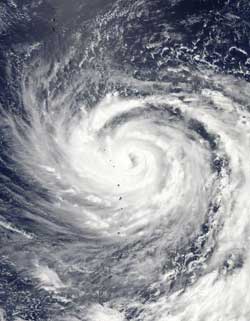NASA satellite sees Typhoon Ma-on soaking Guam

This image was captured by the MODIS instrument that flies aboard NASA's Aqua satellite. It shows Typhoon Ma-on at 03:30 UTC on July 14 (11:30 p.m. EDT on July 13) moving through the western North Pacific Ocean, over the Northern Mariana Islands.<br>Credit: NASA Goddard/MODIS Rapid Response Team, Jeff Schmaltz<br>
Over the last couple of days, NASA satellite data from both the Tropical Rainfall Measuring Mission (TRMM) and Atmospheric Infrared Sounder (AIRS) that flies aboard Aqua detected powerful thunderstorms within Ma-on. Those thunderstorms contained heavy rainfall, falling at a rate of 2 inches/50 mm per hour. As NASA's Aqua satellite flew over Ma-on on July 14 (11:30 p.m. EDT on July 13), the Moderate Resolution Imaging Spectradiometer (MODIS) instrument captured a visible image of Typhoon Ma-on moving over the Northern Mariana Islands.
At 1500 UTC (11 a.m. EDT/1 a.m. Guam local time) on July 14, Typhoon Ma-on had maximum sustained winds near 95 knots (109 mph/175 kmh). It was located over the northern Marianas islands, about 250 nautical miles southeast of Iwo To, Japan near 20.3 North and 144.5 East. It was moving west near 11 knots (13 mph/20 kmh).
The National Weather Service flood advisory for today, July 14 at 11 a.m. Eastern Daylight Time (1 a.m. local time/Guam on July 15) noted that “additional rainfall amounts of 1 to 2 inches are possible during the next several hours. Recent heavy rains have left the ground saturated.”
High surf conditions are also expected in Guam, Rota, Tinian and Saipan over the next several days. At 3:50 p.m. CHST (local time in Guam) on July 14 the National Weather Service (NWS) also issued a high surf advisory that will remain in effect through 6 a.m. (local time) on Sunday, July 17 as Ma-on passes through the region. The NWS advisory states that “Surf will build to hazardous at 7 to 9 feet along west facing reefs tonight and Friday. Surf will peak at 9 to 11 feet Friday night and Saturday, and should fall below 9 feet on Sunday.” Beaches and exposed reefs are places to avoid through the advisory period, especially those facing the west as Ma-on continues to move in that direction. Rip currents are also possible.
There is also a small craft advisory in effect for the coastal waters of Guam, Rota, Tinian and Saipan until 6 p.m. (local time) Sunday as seas are expected to rise to 10 to 12 feet accompanied by winds between 20 and 25 knots (23-29 mph/37-46 kmh) through Saturday night.
Updated weather forecasts and advisories from the NWS for Guam can be found at: http://www.prh.noaa.gov/pr/guam/.
Media Contact
More Information:
http://www.nasa.govAll latest news from the category: Earth Sciences
Earth Sciences (also referred to as Geosciences), which deals with basic issues surrounding our planet, plays a vital role in the area of energy and raw materials supply.
Earth Sciences comprises subjects such as geology, geography, geological informatics, paleontology, mineralogy, petrography, crystallography, geophysics, geodesy, glaciology, cartography, photogrammetry, meteorology and seismology, early-warning systems, earthquake research and polar research.
Newest articles

Zap Energy achieves 37-million-degree temperatures in a compact device
New publication reports record electron temperatures for a small-scale, sheared-flow-stabilized Z-pinch fusion device. In the nine decades since humans first produced fusion reactions, only a few fusion technologies have demonstrated…

Innovative microscopy demystifies metabolism of Alzheimer’s
Researchers at UC San Diego have deployed state-of-the art imaging techniques to discover the metabolism driving Alzheimer’s disease; results suggest new treatment strategies. Alzheimer’s disease causes significant problems with memory,…

A cause of immunodeficiency identified
After stroke and heart attack: Every year, between 250,000 and 300,000 people in Germany suffer from a stroke or heart attack. These patients suffer immune disturbances and are very frequently…





















